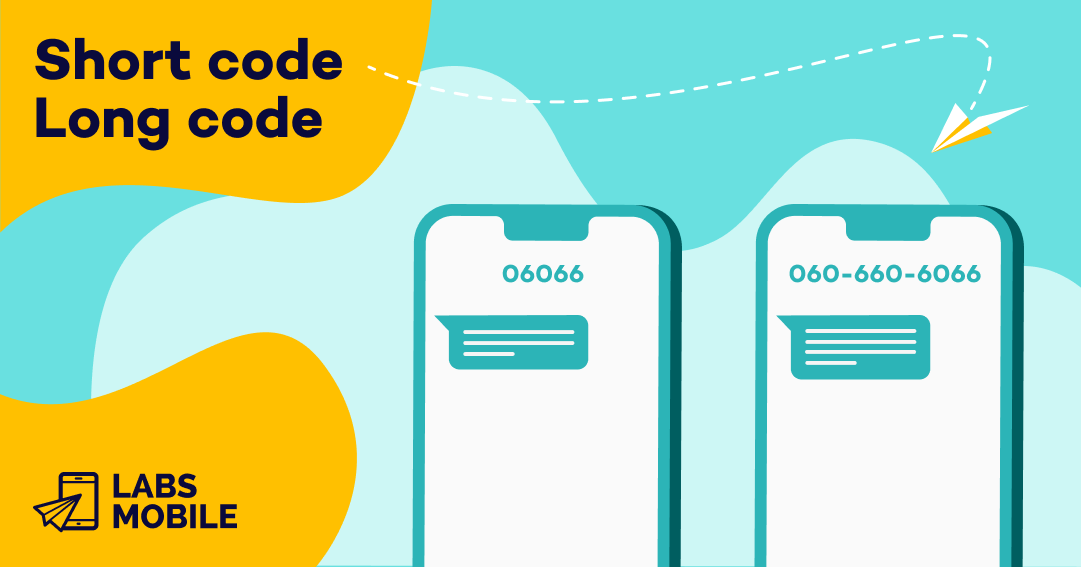Last update: Aug 22, 2022
The differences between a longcode and a shortcode


The sender is one of the most important elements when sending SMS massively. That is, the sender, be it long or shortcode, shows who’s sending the message to the receivers. It’s an element that allows for recognition when a person receives it. The sender has a maximum of 16 digits or 11 alphanumeric characters. Only standard characters (a-zA-Z0-9) are valid under risk of getting delivery errors by operators or receivers.
Today, with some fraudulent activities, sending messages with the same sender is a guarantee of recognizing the brand and to produce reliability and trust in the receiver and in the content.
In this sense, there are 3 types of senders. As we have mentioned before, the shortcode, the longcode, and also the alphanumeric sender.
Longcodes contain a 10-digit number and shortcodes can be 5 or 6 elements long. For its part, the alphanumeric sender, only allowed in some countries, is a combination of numbers and letters with which the sender can create a recognizable name when sending messages.
In this case, we will focus on the numerical codes, therefore, below, we define both concepts so that you can decide what type of sender and sender you want for your message campaigns or which ones are available in your geographical area. The characteristics of the following classification will be based on whether the sender is:
A longcode is a standard phone number used to send and receive SMS messages.
It can consist in:
This long number can be always the same (assigned to a client or shared by a number of issuers) or assigned randomly (that is, each SMS can be sent from a different number as a sender).
In turn, this can be helpful in establishing a single consistent channel for all forms of customer communication. In this way, all the SMS messages sent are grouped in the same conversation, the recipients recognize the number and acquire maximum confidence from the sender.
In addition, a message originating from a long code number is perceived as coming from a person, not from an automated system, which makes longcodes perfect for programming a personalized service and communication experience for the customer or user.
The most common usages from a long code are:
On the other hand, a short code has the same functionalities. This is a short and brief phone number purchased for two-way messaging. Short codes, as well as long codes, are also used to send and receive SMS messages to and from mobile phones.
This formula is very common for B2C traffic, for corporate communications.
These uses include:
In general terms, and for highly reliable routes, we can say that dynamic, numeric and alphanumeric senders are common in Europe. While in the United States longcodes (toll-free / fixed) or shortcodes are more common. In Latam, some countries usually have the possibility of shared or dedicated longcodes, but the most common senders in these countries are shared shortcodes. But in all cases, it will depend on the SMS route chosen within the limitations of the country and also on each operator within the country.
These types of limitations help prevent fraud and the sending of unauthorized messages.
For more information, you can consult with LabsMobile’s support team.
With these concepts we can add a service that provides a high quality of communication to the mass sending of SMS: the Verified messages by Google.
The messages verified by Google are text messages where the Google company itself verifies their origin. The fact that this process takes place means that they have more quality in reference to their origin, since it will have been previously verified and any type of delivery such as SPAM or fraudulent message is discarded.
In general, this brand value translates into numbers, with a +27% increase in conversions, since the user is fully able to identify and trust the issuer. Google shows that 71% of consumers trust the content of an SMS more when the company sends it through a verified SMS.
On our part, from LabsMobile we provide this service for any of our users with simple steps you can discover in this link.
This functionality is available in countries with a dynamic sender or dedicated number assignment, such as Spain, Italy, Portugal, Mexico, Chile, the United States, etc.